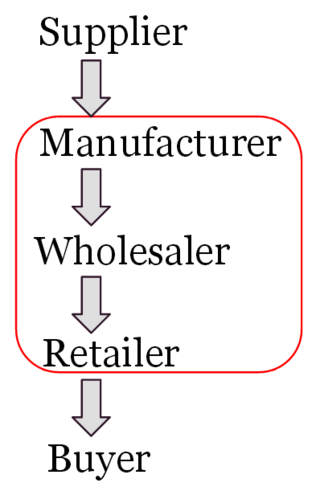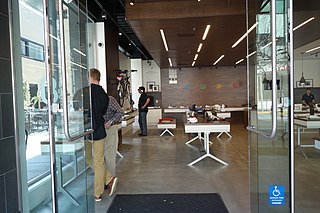E-commerce is the activity of electronically buying or selling products on online services or over the Internet. E-commerce draws on technologies such as mobile commerce, electronic funds transfer, supply chain management, Internet marketing, online transaction processing, electronic data interchange (EDI), inventory management systems, and automated data collection systems. E-commerce is the largest sector of the electronics industry and is in turn driven by the technological advances of the semiconductor industry.

Retail is the sale of goods and services to consumers, in contrast to wholesaling, which is the sale to business or institutional customers. A retailer purchases goods in large quantities from manufacturers, directly or through a wholesaler, and then sells in smaller quantities to consumers for a profit. Retailers are the final link in the supply chain from producers to consumers.

Disintermediation is the removal of intermediaries in economics from a supply chain, or "cutting out the middlemen" in connection with a transaction or a series of transactions. Instead of going through traditional distribution channels, which had some type of intermediary, companies may now deal with customers directly, for example via the Internet.

Online shopping is a form of electronic commerce which allows consumers to directly buy goods or services from a seller over the Internet using a web browser or a mobile app. Consumers find a product of interest by visiting the website of the retailer directly or by searching among alternative vendors using a shopping search engine, which displays the same product's availability and pricing at different e-retailers. As of 2020, customers can shop online using a range of different computers and devices, including desktop computers, laptops, tablet computers and smartphones.

Once the strategic plan is in place, retail managers turn to the more managerial aspects of planning. A retail mix is devised for the purpose of coordinating day-to-day tactical decisions. The retail marketing mix typically consists of six broad decision layers including product decisions, place decisions, promotion, price, personnel and presentation. The retail mix is loosely based on the marketing mix, but has been expanded and modified in line with the unique needs of the retail context. A number of scholars have argued for an expanded marketing, mix with the inclusion of two new Ps, namely, Personnel and Presentation since these contribute to the customer's unique retail experience and are the principal basis for retail differentiation. Yet other scholars argue that the Retail Format should be included. The modified retail marketing mix that is most commonly cited in textbooks is often called the 6 Ps of retailing.
A virtual business employs electronic means to transact business as opposed to a traditional brick and mortar business that relies on face-to-face transactions with physical documents and physical currency or credit.
Direct-to-consumer or business-to-consumer (B2C) is the business model of selling products directly to customers and thereby bypassing any third-party retailers, wholesalers, or middlemen. Direct-to-consumer sales are usually transacted online, but direct-to-consumer brands may also operate physical retail spaces as a complement to their main e-commerce platform in a clicks-and-mortar business model. In the year 2021, direct-to-customer e-commerce sales in the United States were over $128 Billion.
Free shipping is a marketing tactic used primarily by online vendors and mail-order catalogs as a sales strategy to attract customers.
Non-store retailing is the selling of goods and services outside the confines of a retail facility. It is a generic term describing retailing taking place outside of shops and stores. The non-store distribution channel can be divided into direct selling and distance selling, the latter including all forms of electronic commerce. Distance selling includes mail order, catalogue sales, telephone solicitations and automated vending. Electronic commerce includes online shopping, internet trading platforms, travel portals, global distribution systems and teleshopping. Direct selling includes party sales and all forms of selling in consumers' homes and offices, including even garage sales.
Omnichannel is a neologism describing a business strategy. According to Frost & Sullivan, omnichannel is defined as "seamless and effortless, high-quality customer experiences that occur within and between contact channels".

Showrooming is the practice of examining merchandise in a traditional brick-and-mortar retail store or other offline setting, and then buying it online, sometimes at a lower price. Online stores often offer lower prices than their brick-and-mortar counterparts because they do not have the same overhead cost. Staff writers at the Wharton School have observed that showrooming and buying elsewhere is not new in itself, but its impact has become more significant with the greater availability of online purchasing.

Omnichannel retail strategy, originally also known in the U.K. as bricks and clicks, is a business model by which a company integrates both offline (bricks) and online (clicks) presences, sometimes with the third extra flips.

The Marketplace Fairness Act was a proposed legislation pending in the United States Congress that would enable state governments to collect sales taxes and use taxes from remote retailers with no physical presence in their state.

A dark store is a retail outlet or distribution centre that exists exclusively for online shopping. A dark store is generally a large warehouse that can either be used to facilitate a "click-and-collect" service, where a customer collects an item they have ordered online, or as an order fulfillment platform for online sales. The format was initiated in the United Kingdom, and its popularity has also spread to France followed by the rest of the European Union and Russia, as well as to the United States.
There are many types of e-commerce models, based on market segmentation, that can be used to conducted business online. The 6 types of business models that can be used in e-commerce include: Business-to-Consumer (B2C), Consumer-to-Business (C2B), Business-to-Business (B2B), Consumer-to-Consumer (C2C), Business-to-Administration (B2A), and Consumer-to-Administration
Mobile location analytics (MLA) is a type of customer intelligence and refers to technology for retailers, including developing aggregate reports used to reduce waiting times at checkouts, improving store layouts, and understanding consumer shopping patterns. The reports are generated by recognizing the Wi-Fi or Bluetooth addresses of cell phones as they interact with store networks.

Retail apocalypse refers to the closing of numerous brick-and-mortar retail stores, especially those of large chains, beginning around 2010 and accelerating due to the mandatory closures during the COVID-19 pandemic.

b8ta was a retail-as-a-service company which serve as presentation centers for consumer electronics and home goods. The company was founded in 2015 by Vibhu Norby, William Mintun, Phillip Raub, and Nicholas Mann. Its first location opened in Palo Alto in December 2015. Companies could pay to rent out space for their product to be displayed inside the locations, along with a tablet that each brand customizes with software. All of the products in stores were on display out-of-the-box and could be touched and demoed. The company also sold the products directly to consumers. Store employees, which the company calls "b8ta testers", assisted customers with demos and product information which is taught to them by companies with products on display. In November 2019, b8ta opened a fashion store named Forum in West Hollywood with the same business model.
The disruptive effect of e-commerce on the global retail industry has been referred to as the Amazon Effect: the term refers to Amazon.com's dominant role in the e-commerce market place and its leading role in driving the disruptive impact on the retail market and its supply chain.
The retail format influences the consumer's store choice and addresses the consumer's expectations. At its most basic level, a retail format is a simple marketplace, that is; a location where goods and services are exchanged. In some parts of the world, the retail sector is still dominated by small family-run stores, but large retail chains are increasingly dominating the sector, because they can exert considerable buying power and pass on the savings in the form of lower prices. Many of these large retail chains also produce their own private labels which compete alongside manufacturer brands. Considerable consolidation of retail stores has changed the retail landscape, transferring power away from wholesalers and into the hands of the large retail chains.













